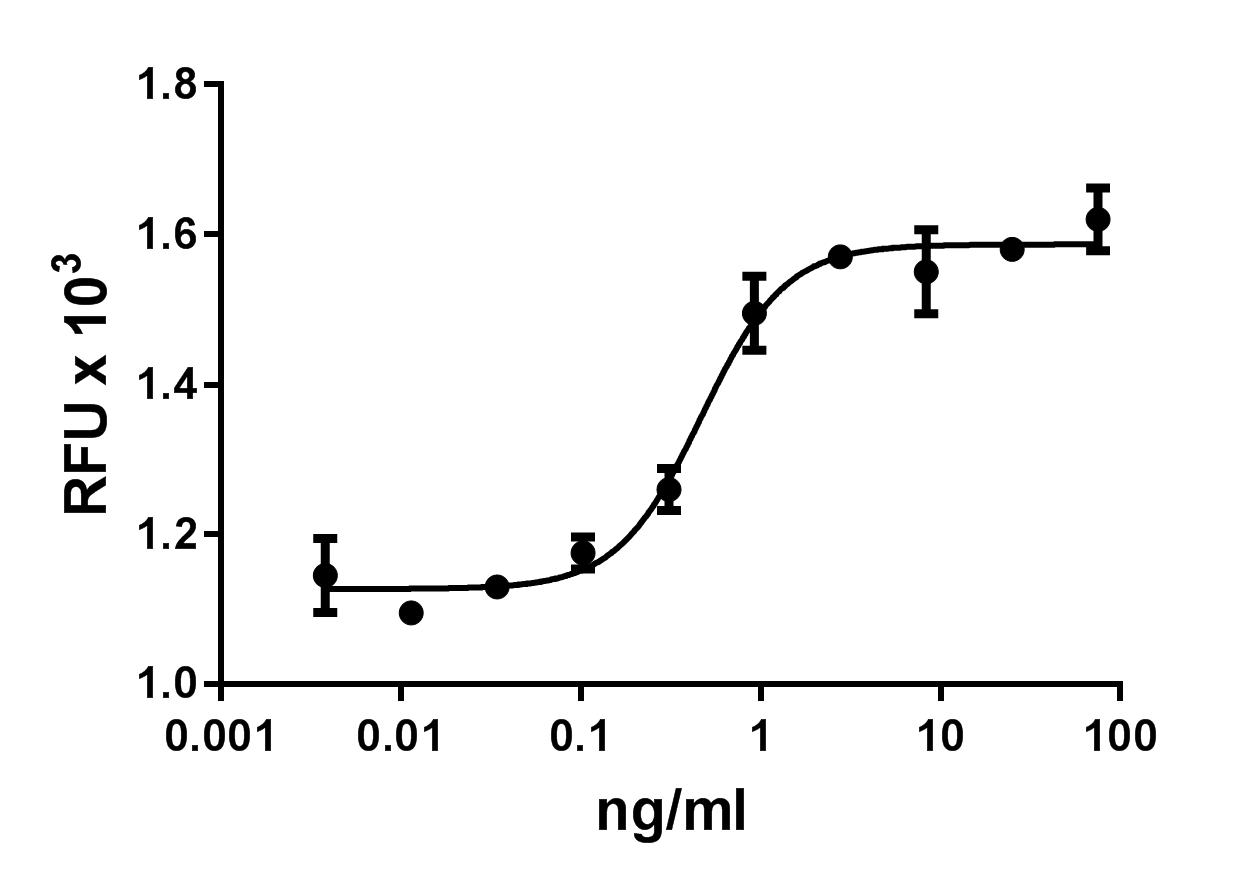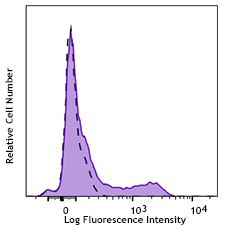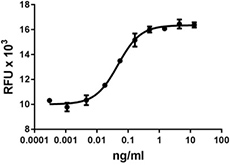- Regulatory Status
- RUO
- Other Names
- Tumor necrosis factor receptor superfamily member 6 (TNFRSF6), ALPS1A, APO-1, Apoptosis antigen 1 (APT1), CD95, FAS1, FASTM, FS-7-associated surface antigen
- Ave. Rating
- Submit a Review
| Cat # | Size | Price | Quantity Check Availability | Save | ||
|---|---|---|---|---|---|---|
| 555004 | 25 µg | £157 | ||||
| 555006 | 100 µg | £398 | ||||
FAS was initially purified and cloned from SKW6.4 cells and a cDNA library of human T cell lymphoma KT-3 cells. FAS is a type I transmembrane protein and belongs to the TNF receptor superfamily. The extracellular region of FAS possesses three cystein-rich domains characteristic of the TNF superfamily, and the intracellular region which includes a death domain (DD). The binding of FASL to FAS induces conformational changes in FAS, leading to the recruitment of FADD and procaspase-8 and the assembly of the death-inducing signaling complex (DISC). Subsequently, caspase 8 is released from DISC and induces activation of caspase 3 and 7, proteolysis of cellular components, and apoptosis. Other biological effects not leading to apoptotic cell death have also been described. The interaction of FAS/FASL in immature dendritic cells (DCs) induces functional maturation. Fas-activated DCs increase the expression of MHC II, B7 co-stimulatory molecules, and DC-lysosome-associated membrane proteins (DC-LAMP), and secrete proinflammatory cytokines such as IL-1β and TNF-α. In addition, FAS/FASL interaction increases the production of chemokines in NK-T cells, and FASL acts as a survival factor for human CD34+ cells and increases their colony formation. Human activated PBMC and tumor cell lines express full-length mRNA and several mRNA FAS variants derived by alternative splicing; deletion of an exon encoding the transmembrane domain results in a soluble FAS molecule that blocks apoptosis. Patients with systemic lupus erythematosus show high levels of sFAS.
Product DetailsProduct Details
- Source
- Human FAS, amino acids (Arg17-Asn173) (Accession# NM_000043), was expressed in 293E cells. IgG-Fc-6His tag is located at the C-terminal.
- Molecular Mass
- The 397 amino acid recombinant protein has a predicted molecular mass of approximately 44.7 kD. The DTT-reduced and non-reduced protein migrate at approximately 55 - 60 kD and 120 kD respectively by SDS-PAGE. The predicted N-terminal amino acid is Arg.
- Purity
- >95%, as determined by Coomassie stained SDS-PAGE.
- Formulation
- 0.22 µm filtered protein solution is in 10 mM NaH2PO4, 0.3 M NaCl, pH 7.2.
- Endotoxin Level
- Less than 0.1 ng per µg cytokine as determined by the LAL method.
- Concentration
- 10 and 25 µg sizes are bottled at 200 µg/mL. 100 µg size and larger sizes are lot-specific and bottled at the concentration indicated on the vial. To obtain lot-specific concentration and expiration, please enter the lot number in our Certificate of Analysis online tool.
- Storage & Handling
- Unopened vial can be stored between 2°C and 8°C for up to 2 weeks, at -20°C for up to six months, or at -70°C or colder until the expiration date. For maximum results, quick spin vial prior to opening. The protein can be aliquoted and stored at -20°C or colder. Stock solutions can also be prepared at 50 - 100 µg/mL in appropriate sterile buffer, carrier protein such as 0.2 - 1% BSA or HSA can be added when preparing the stock solution. Aliquots can be stored between 2°C and 8°C for up to one week and stored at -20°C or colder for up to 3 months. Avoid repeated freeze/thaw cycles.
- Activity
- ED50 = 10 - 50 ng/ml, corresponding to a specific activity of 0.02 - 0.1 x 106 units/mg, as determined by inhibition of apoptotic cell death induced by FASL on Jurkat cells.
- Application
-
Bioassay
- Application Notes
-
BioLegend carrier-free recombinant proteins provided in liquid format are shipped on blue-ice. Our comparison testing data indicates that when handled and stored as recommended, the liquid format has equal or better stability and shelf-life compared to commercially available lyophilized proteins after reconstitution. Our liquid proteins are verified in-house to maintain activity after shipping on blue ice and are backed by our 100% satisfaction guarantee. If you have any concerns, contact us at tech@biolegend.com.
Antigen Details
- Distribution
-
Activated human T cells, B cells, malignant human lymphoid cell lines, fibroblasts, dendritic cells, thymocytes, macrophages, cardiomyocytes, hepatocytes.
- Function
- Plays a role in apoptotic clearance of virus-infected cells and contributes to the shutdown of chronic immune responses and to maintenance of peripheral tolerance. Soluble FAS modulates cell apoptosis.
- Interaction
- Lymphocytes T (mainly CD8+), NK cells.
- Ligand/Receptor
- TNFLSF6 (FASL).
- Cell Type
- Embryonic Stem Cells
- Biology Area
- Apoptosis/Tumor Suppressors/Cell Death, Cell Biology, Immunology, Stem Cells
- Molecular Family
- Cytokine/Chemokine Receptors
- Antigen References
-
1. Oehm A, et al. 1992. J. Biol. Chem. 267:10709.
2. Cheng J, et al. 1994. Sciences 263:1759.
3. Papoff G, et al. 1996. J. Immunol. 156:4622.
4. Rescigno M, et al. 2000. J. Exp. Med. 192:1661.
5. Giroux M, et al. 2005. Blood 105:703.
6. Kovacic N, et al. 2010. Expert Opin. Ther. Targets 14:1121. - Gene ID
- 355 View all products for this Gene ID
- UniProt
- View information about FAS on UniProt.org
Related FAQs
- Why choose BioLegend recombinant proteins?
-
• Each lot of product is quality-tested for bioactivity as indicated on the data sheet.
• Greater than 95% Purity or higher, tested on every lot of product.
• 100% Satisfaction Guarantee for quality performance, stability, and consistency.
• Ready-to-use liquid format saves time and reduces challenges associated with reconstitution.
• Bulk and customization available. Contact us.
• Learn more about our Recombinant Proteins. - How does the activity of your recombinant proteins compare to competitors?
-
We quality control each and every lot of recombinant protein. Not only do we check its bioactivity, but we also compare it against other commercially available recombinant proteins. We make sure each recombinant protein’s activity is at least as good as or better than the competition’s. In order to provide you with the best possible product, we ensure that our testing process is rigorous and thorough. If you’re curious and eager to make the switch to BioLegend recombinants, contact your sales representative today!
- What is the specific activity or ED50 of my recombinant protein?
-
The specific activity range of the protein is indicated on the product datasheets. Because the exact activity values on a per unit basis can largely fluctuate depending on a number of factors, including the nature of the assay, cell density, age of cells/passage number, culture media used, and end user technique, the specific activity is best defined as a range and we guarantee the specific activity of all our lots will be within the range indicated on the datasheet. Please note this only applies to recombinants labeled for use in bioassays. ELISA standard recombinant proteins are not recommended for bioassay usage as they are not tested for these applications.
- Have your recombinants been tested for stability?
-
Our testing shows that the recombinant proteins are able to withstand room temperature for a week without losing activity. In addition the recombinant proteins were also found to withstand four cycles of freeze and thaw without losing activity.
- Does specific activity of a recombinant protein vary between lots?
-
Specific activity will vary for each lot and for the type of experiment that is done to validate it, but all passed lots will have activity within the established ED50 range for the product and we guarantee that our products will have lot-to-lot consistency. Please conduct an experiment-specific validation to find the optimal ED50 for your system.
- How do you convert activity as an ED50 in ng/ml to a specific activity in Units/mg?
-
Use formula Specific activity (Units/mg) = 10^6/ ED50 (ng/mL)


 Login / Register
Login / Register 



_Fc_Human_RECOM_BA_081914.jpg&Width=240&Height=300&altFmImage_path=&Compression=90&Crop=5)
_Fc_Human_RECOM_BA_081914.jpg&Height=80&altFmImage_path=&Compression=90&Crop=5)















Follow Us